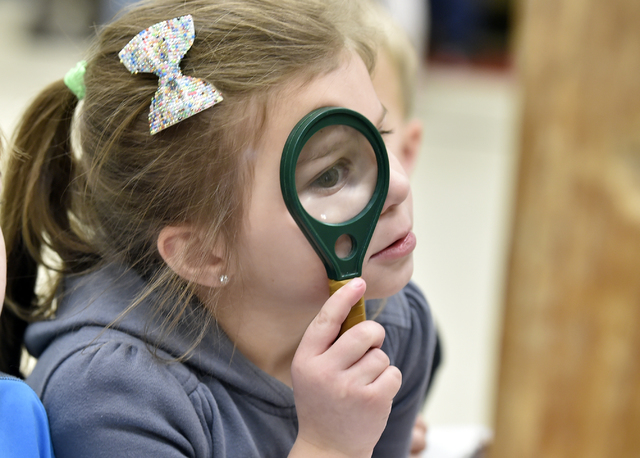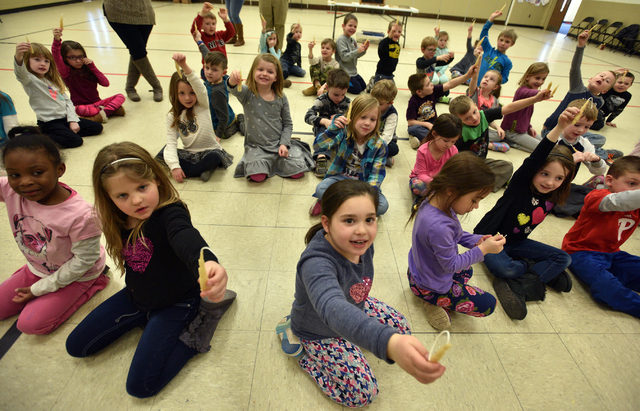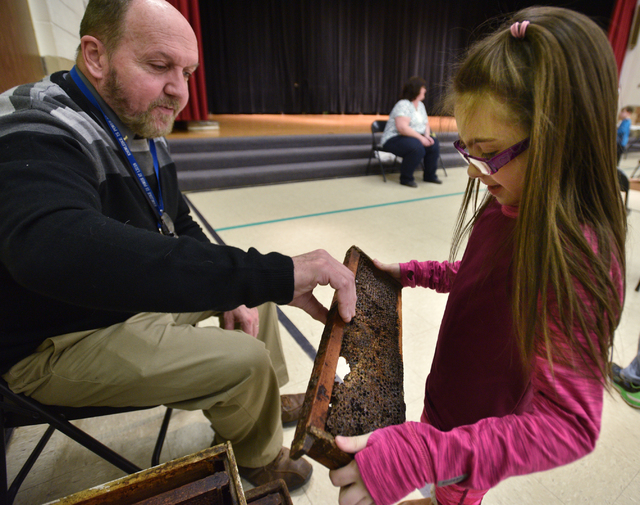LEHMAN TWP. — Honeybees have five eyes.
That was surprising news to Lehman-Jackson fifth-grader Hailey Martin.
“I thought they only had two,” she said after attending Cliff Wright-Sunflower’s “Dancin’ with the Honeybees” presentation and workshop at Lehman-Jackson Elementary School in Lehman Township on Feb. 17.
Honeybees have two compound eyes and three smaller eyes, Wright-Sunflower said.
Honeybee biology is not the only thing kindergarten, fourth, fifth and sixth-graders learned from Wright-Sunflower, a beekeeper and owner of Bear Honey Farms in Morristown.
First, second and third-grade students attended the assembly and workshop on Feb. 14.
Wright-Sunflower’s hands-on program described the interworkings of a hive and encouraged children to think of ideas to help save honeybees.
The little, six-legged flying insects highly developed communal living hierarchy has contributed to its long-term survival, but man-made insecticides and environmental issues are causing a steady honeybee population decline, he said.
With a simple chant, Wright-Sunflower stressed the importance of honeybees for humans, “Bees help make the food. Pollination. Pollination. Food for us.”
The students repeated the chant.
Wright-Sunflower gave students a peek inside a once-active hive and explained each “bee job” and how each role helps crops to grow and produce fruits and vegetables.
But first, bee safety.
Sixth-grader Brady Law volunteered to learn to be a beekeeper. Wright-Sunflower helped Law put on a beekeeper’s suit, a white hat with an attached black veil and white gloves.
He also demonstrated how a beekeeper uses a hand-held smoker, which is a can with a spout at the top and a bellow attached to it.
A small fire inside the can creates smoke containing pheromones. The smoke is directed into the hive to enable the beekeeper an opportunity to collect honey and beeswax, he said.
“Bees smell smoke. Bees calm down,” he said.
Wright-Sunflower took the students through the hive one layer at a time as Law pretended to smoke the already empty hive.
“Top section (of the hive) is where the honey is,” he said.
Wright-Sunflower pulled out a honeycomb frame from the hive where the bees were once actively making honey and wax.
He demonstrated how a beekeeper carefully cuts the wax off the honeycombs.
After the bees’ wax is removed, the frame is put inside a “honey extractor,” which spins the honey out of the cones, Wright-Sunflower said.
He opened the bottom layer of the hive revealing where the infant bees are located.
“This is where the baby bees are, but this is a science program, so we don’t call them baby bees,” he said. “We call them brood.”
Brood is the larvae stage of a bees’ life, he said.
Wright-Sunflower chose a dozen audience members to represent the brood and had them sit on stage.
Then he asked for a volunteer to portray the queen bee.
Fifth-grader Calli Dieffenbacher was tabbed and Wright-Sunflower taught her how to do the queen’s sidestep, sidestep, squat to lay eggs in one of the honeycomb cells.
“The queen does not rule the hive,” Wright-Sunflower said. “The queen’s only job is to lay eggs. She will lay 1,000 eggs a day.”
The queen bee has a court of about 25 bees whose job is to take care of her daily needs, he said.
About a dozen students were picked to represent the “queen’s court” and surrounded Dieffenbacher in her two-step squat routine on the stage.
Meanwhile, members of the brood sat quietly on stage and occasionally called out “feed me” in their tiniest voices.
Then, Wright-Sunflower picked another dozen audience volunteers to represent the “nursemaids” bees who collect pollen and turn it into “royal jelly” for the brood to eat.
The “nursemaid bee” volunteers had a routine to follow of their own, requiring them to pretend to eat the pollen and create food for the brood.
Other students and teachers were selected for other bee roles such as:
• drones, who represented the few male bees in the hive whose primary job is to fertilize the queen;
• funeral bees, who carry the deceased bees out of the hive and place them in the grass;
• guard bees to protect the hive;
• field bees who fly out to collect honey and pollen from the flowers; and
• flowers, who were represented by the remaining audience members.
When Wright-Sunflower had each student group performing its “bee job” simultaneously, the Lehman-Jackson Elementary School gymnasium was transformed into a busy, buzzing hive.
The hour-long assembly ended and the students returned to their classrooms.
At this time, Wright-Sunflower set up his seven-station bee museum, which contained a live bee hive, a bee identification table, a former hive, a table about how bees see, the beekeeping station, a honey-tasting table and a beeswax candle.
The students returned to the gymnasium in smaller groups to explore the seven stations and learn more about bees.
He encouraged the students to develop posters to hang in their grocery store, build a bee box or plant a flower garden.
“Save the bees – food for us,” he said.
Monica Law, a member of the Parent Teacher Organization, said Wright-Sunflower held his program at the school about 12 years ago and the teachers requested that he return.
Wright-Sunflower has been performing his hands-on program for nearly 30 years, averaging 50 to 60 shows a year.










